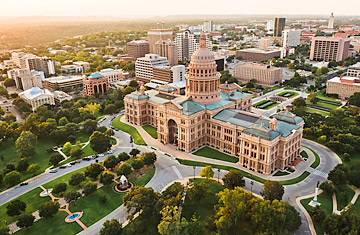
Overview of the State Capitol Building in Austin, Texas.
(2 of 2)
If there is anything that gives Yanosy pause, it is the uncertainty that hangs in the air these days given the state of play in the world beyond Texas. "The challenge is so much is out of our control," he says. "We live in uncertain times." Gas prices, healthcare, tax policy all add to anxiety for consumers and businessowners, he says, adding: "Texas is a good place — we know the ground rules and we know they are not going to change."
There is a note of caution in Yanosy's voice, but he insists he is optimistic. "We are a country of optimism," he says, adding that this is the time for American adventurers to "put a marker in the ground." He senses, also that people believe a recovery is at hand: "I think there is an anticipation. They know its coming." Austin's economic future looks good, according to economist Angelos Angelou, who gave his 26th annual Austin forecast last month. Angelou predicts the metro area would add 45,000 jobs in 2012 and 2013, next year the unemployment rate would be 5.6%, down from its current rate of 6.3%.
Over the last decade or so, Austin has become accustomed to basking in the glow of gaudy headlines — number one on this list, in the top 10 on another. Austin recently posted a high score on Gallup's list of the most optimistic communities. It also garnered kudos as one of the nation's "top intelligent communities" and one of the "healthiest cities for women," not to mention being home to Paul Qui, the latest Top Chef. The city's reputation for hot events like the recent SXSW and the upcoming Formula One race add to the luster. But there is a nagging feeling in the city, voiced on talk radio and in occasional coffee shop conversations that it will be a struggle to — as the popular local bumper says — "Keep Austin Weird."
Bruce Springsteen and Jay-Z now headline the once funky SXSW. Hotel prices are predicted to be stratospheric and rooms elusive during the first Formula One race, scheduled for late this year. Meanwhile, Austin has seen parts of the old Hispanic barrio close to downtown turn into hipster havens of brew pubs and food trailers. An old courtyard-style motel where the small cottages served as home to a parade of Austin musicians closed to make way for more profitable development. The search for affordable housing has spread miles beyond the city limits. Amid all this hype and change, hope hangs in the air that the authentic Austin does not become as elusive as an affordable home inside the city.
One of the young Austin residents dealing with that reality, both personally and professionally, is Ivan Davila, a 30-year-old social worker at El Buen Samaritano, a social services mission run by the Episcopal church. Working on a recent report on the mission's activities, he and fellow worker decided to title their work "A Tale of Two Cities." In 2010, according to the U.S. Census, 18% of all Texans lived in poverty, three points above the national average. In Austin, the percentage was higher and one in five lived in poverty. For children, the rate was even higher, 28% of children under 18, the third year the rate had risen.
The mission of El Buen Samaritano has been to serve Central Texas' poor and immigrant community, the men who built the roads, homes, shopping centers in the boom times, the women who staffed the cafeterias, and worked as maids and nannies. Amidst the hype about Austin and the tangible, real energy of the city, amid the optimistic air and the joy that comes from watching a city blossom and constantly reinvent itself, Davila offers two small observations: In Janaury, 2011 El Buen Samaritano's food bank had 1,475 clients and a year later, in January, 2012 the number had grown to 1,948.
